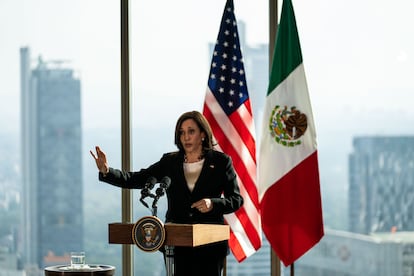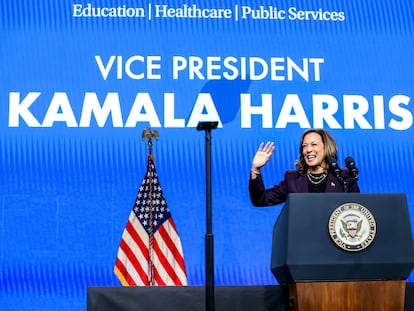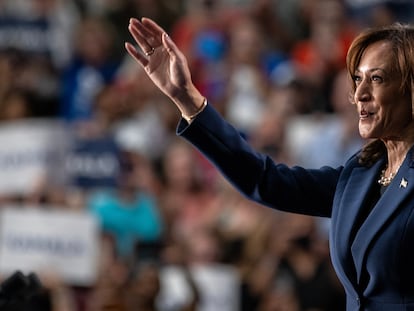No, Kamala Harris was never the ‘border czar’
While the vice president has indeed played an immigration-related role under Biden, her responsibilities are often mischaracterized. The reality is that her role has been diplomatic


“We strongly condemn the failure of the Biden Administration and its ‘border czar,’ Kamala Harris, to secure the U.S. border,” reads a resolution approved Thursday by the House of Representatives, where the Republican Party holds the majority; in fact, all of its members voted in favor of the document. They were not the only ones: six Democrats supported the initiative, demonstrating how the migration crisis and its management by the Joe Biden government looms over Harris’ campaign for the presidency.
When Joe Biden announced last Sunday that he was renouncing re-election, choosing to fully support his vice president as his successor, Republicans were quick to launch their attacks, which they had probably already prepared, given that the president’s withdrawal had been anticipated for days. “The only difference” between Biden and Harris, wrote the former president and current Republican candidate, Donald Trump, on his social networks, “is that she is even more liberal and less competent than Joe, which is saying a lot. They put her in charge of the border and we saw the worst invasion of illegals in our history.” His vice presidential candidate, J. D. Vance, followed the same line: “For the last four years, [Harris] endorsed Biden’s open border policies.” “She owns all of those failures,” he added.
One accusation in particular has resonated over the past week from the Republican camp. Or, rather, one label: “border czar.” Starting with Trump himself and ending in Congress, Republicans have focused on accusing Harris of failing to stem immigration across the country’s southern border, which skyrocketed during the first three years of the Biden administration. Specifically, after a sustained rise since 2021, authorities intercepted 249,735 migrants in December 2023, a record. That is why insults from Trump and his allies often begin or end with “Harris, the border czar.”
But the reality is that Harris has never officially held that position. The vice president has not personally been in charge of the border or controlling border crossings. In fact, the migration-related task that the president gave her in March 2021 had more to do with diplomacy than border oversight. Early in his term, Biden asked Harris to coordinate diplomatic relations with the so-called Northern Triangle of Central America — El Salvador, Guatemala and Honduras — to address the “root causes” of migration from these three countries.
“Diplomatic effort”
“I have asked the vice president — because she is the most qualified person to do so — to lead our efforts with Mexico and the Northern Triangle and the countries that need help to stem migration to our southern border,” Biden said during an event at the White House on March 24, 2021. “She has agreed to lead our diplomatic effort and work with those nations to accept returnees and improve migration control at their borders,” the president added.
Harris responded: “While we are clear that people should not come to the border now, we also understand that we are going to enforce the law and that we also — because we can chew gum and walk at the same time — we must address the root causes that make people make the journey, as the president has described, to come here.” To that end, the vice president specified that she would work “with the government, with the private sector, with civil society, and with the leaders of El Salvador, Guatemala, and Honduras to strengthen democracy and the rule of law, and to guarantee shared prosperity in the region.”

Her responsibility, therefore, was to lead a strategy to improve economic and security conditions in El Salvador, Guatemala and Honduras, countries that then accounted for the majority of migrants arriving in the United States (a trend that began to change in recent years, with more migrants coming from countries such as Venezuela and Ecuador). The plan was to encourage job creation, the fight against corruption, the improvement of human and labor rights and the reduction of violence, in order to stop migration to the north.
Since then, Harris' role has been to promote investment in Central America. In March of this year, the White House announced that since March 2021, Harris had secured private sector commitments to invest more than $5 billion to promote economic opportunities and reduce violence in the region.
Now, both parties can debate whether Harris’ efforts have been fruitful or not, but the reality is that the Biden administration made clear from the beginning that addressing the “root causes” of migration would be a long-term strategy. “Even with strong and sustained commitment, the type of systemic change envisioned in this strategy will take time to achieve, and progress will not be linear,” the administration warned in a 2021 document outlining the plan.
Friendly fire
While most of her critics have been Republicans, Harris has also faced rebukes from within her own party. During her first visit to Mexico and Central America, a region she was supposed to work closely with, the vice president addressed those who intended to emigrate and issued a firm warning: “I want to be clear with people from this region who are thinking of making the dangerous journey to the U.S.-Mexico border: Do not come,” she said during a press conference in Guatemala in June 2021. She paused and emphasized: “Do not come.”
Not only did she come under fire from the more progressive wing of the Democratic Party, as well as pro-immigration organizations, but her call did little to stop what was to come: illegal border crossings hit record highs in 2021, 2022 and 2023.
Sign up for our weekly newsletter to get more English-language news coverage from EL PAÍS USA Edition
Tu suscripción se está usando en otro dispositivo
¿Quieres añadir otro usuario a tu suscripción?
Si continúas leyendo en este dispositivo, no se podrá leer en el otro.
FlechaTu suscripción se está usando en otro dispositivo y solo puedes acceder a EL PAÍS desde un dispositivo a la vez.
Si quieres compartir tu cuenta, cambia tu suscripción a la modalidad Premium, así podrás añadir otro usuario. Cada uno accederá con su propia cuenta de email, lo que os permitirá personalizar vuestra experiencia en EL PAÍS.
¿Tienes una suscripción de empresa? Accede aquí para contratar más cuentas.
En el caso de no saber quién está usando tu cuenta, te recomendamos cambiar tu contraseña aquí.
Si decides continuar compartiendo tu cuenta, este mensaje se mostrará en tu dispositivo y en el de la otra persona que está usando tu cuenta de forma indefinida, afectando a tu experiencia de lectura. Puedes consultar aquí los términos y condiciones de la suscripción digital.
More information
Archived In
Últimas noticias
How Japan is trying to avert ‘digital defeat’
From digital curfews to blocking apps: How technology experts protect their children online
Why the price of coffee has skyrocketed: from Brazilian plantations to specialty coffee houses
Confined to a Cuban hospital: When electricity is a matter of life or death
Most viewed
- Pablo Escobar’s hippos: A serious environmental problem, 40 years on
- Reinhard Genzel, Nobel laureate in physics: ‘One-minute videos will never give you the truth’
- Why we lost the habit of sleeping in two segments and how that changed our sense of time
- Charles Dubouloz, mountaineering star, retires at 36 with a farewell tour inspired by Walter Bonatti
- The Florida Keys tourist paradise is besieged by immigration agents: ‘We’ve never seen anything like this’










































